
Nepenthes hamata is a tropical pitcher plant endemic to Sulawesi, where it grows at elevations of 1400–2500 m above sea level.

Nepenthes klossii is a tropical pitcher plant endemic to New Guinea.
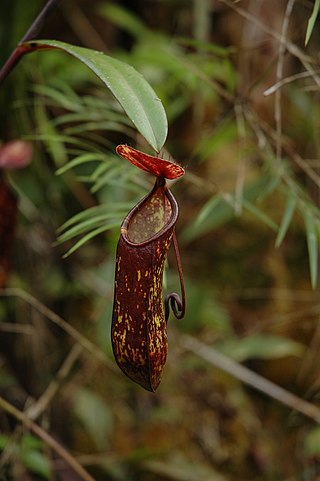
Nepenthes muluensis, or the Mulu pitcher-plant, is a tropical pitcher plant endemic to Borneo. It grows in highland habitats at elevations of 1700 to 2400 m above sea level.

Nepenthes glabrata is a tropical pitcher plant endemic to Sulawesi. The species grows in open, high forest at elevations of 1600 to 2100 m. It produces dainty, colourful pitchers reaching only a few centimetres in height. These traps are red speckled on a yellowish background, giving them a "hand painted" appearance.
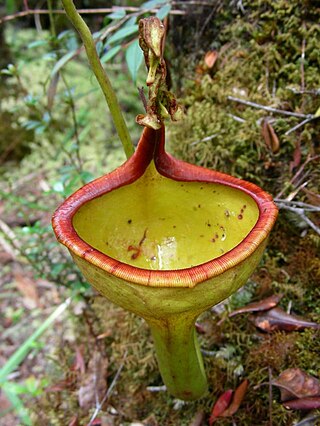
Nepenthes eymae is a tropical pitcher plant endemic to Sulawesi in Indonesia, where it grows at elevations of 1,000–2,000 m (3,300–6,600 ft) above sea level. It is very closely related to N. maxima, from which it differs in its wine glass-shaped upper pitchers.

Nepenthes lamii is a tropical pitcher plant endemic to New Guinea, where it grows at an altitude of up to 3520 m above sea level, higher than any other Nepenthes species. Although once confused with N. vieillardii and previously regarded as conspecific with the closely related N. monticola, it is now recognised as a distinct species.
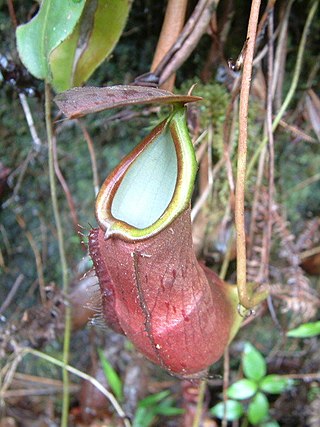
Nepenthes longifolia is a tropical pitcher plant endemic to Sumatra, where it grows at elevations of between 300 and 1100 m above sea level. The specific epithet longifolia, formed from the Latin words longus (long) and folius (leaf), refers to the exceptionally large leaves of this species.
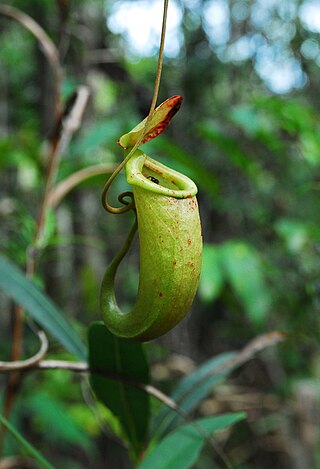
Nepenthes bellii is a tropical pitcher plant endemic to the Philippine islands of Mindanao and Dinagat, where it grows at elevations of 0–800 m above sea level.

Nepenthes jacquelineae is a tropical pitcher plant endemic to the Indonesian island of Sumatra. Due to its unique pitcher morphology, it is considered to be one of the most spectacular Nepenthes species native to the island.
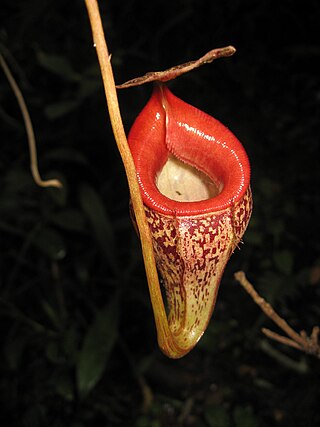
Nepenthes talangensis is a tropical pitcher plant endemic to Sumatra, where it grows in upper montane forest at elevations of 1800–2500 m above sea level.

Nepenthes rigidifolia is a critically endangered tropical pitcher plant endemic to Sumatra, where it grows at elevations of 1000–1600 m above sea level.

Nepenthes izumiae is a tropical pitcher plant endemic to Sumatra, where it grows in montane forest at 1700–1900 m above sea level. It appears to be most closely related to N. lingulata and N. singalana.

Nepenthes jamban is a tropical pitcher plant endemic to northern Sumatra. The specific epithet jamban is the Indonesian word for "toilet" and refers to the shape of the pitchers.

Nepenthes surigaoensis is a tropical pitcher plant endemic to the Philippine island of Mindanao, where it grows at elevations of at least 800–1200 m above sea level.

Nepenthes lingulata is a tropical pitcher plant endemic to northern Sumatra. The species is characterised by the highly developed appendage present on the underside of the lid. The specific epithet lingulata is derived from the Latin word lingula, meaning "small tongue", and refers to this unique morphological feature.
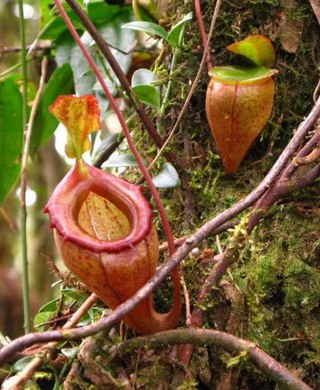
Nepenthes flava is a tropical pitcher plant endemic to northern Sumatra, where it grows in montane forest at 1800–2200 m above sea level.

Nepenthes micramphora is a tropical pitcher plant known only from Mount Hamiguitan on the island of Mindanao in the Philippines. It is a highland plant growing at elevations of 1100–1635 m.
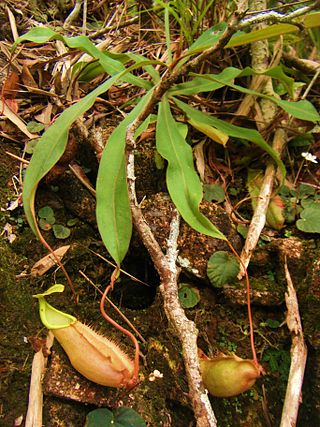
Nepenthes chang is a tropical pitcher plant endemic to the Banthad Mountains of central Thailand, where it grows at elevations of 300–600 m above sea level. It is thought to be most closely related to N. kampotiana.

Nepenthes leonardoi is a tropical pitcher plant known from a single locality in central Palawan, the Philippines. It is closely allied to several other Palawan endemics, including N. deaniana, N. gantungensis, and N. mira. The traps of this species reach at least 24 cm in height. Some specimens are noted for producing very dark, almost black, upper pitchers.

Nepenthes abgracilis is a tropical pitcher plant native to the Philippines. It is known only from northeastern Mindanao, including Mount Legaspi. Little is known about the altitudinal distribution of this species, but the holotype was collected at 670 m.


























